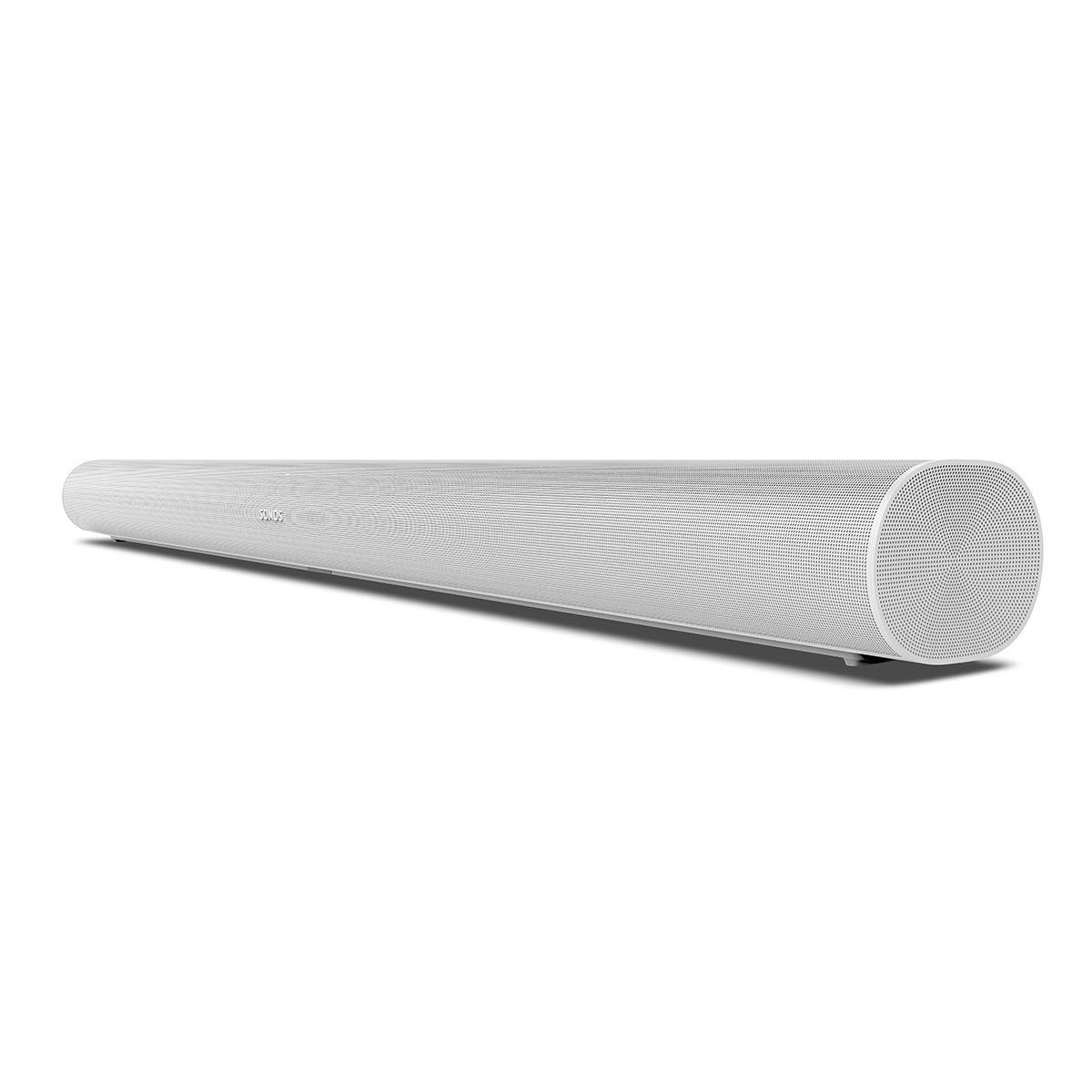
When it comes to upgrading your TV's audio, premium soundbars have become increasingly sophisticated. Let's compare two compelling options: the Sonos Arc ($564.44) and the Samsung HW-S700D ($397.99).
Soundbars have transformed from simple stereo upgrades to sophisticated home theater centerpieces. The Sonos Arc, released in 2020, represented a significant leap forward with Dolby Atmos support and smart features. Samsung's HW-S700D, a more recent release, takes a different approach by prioritizing a slim profile while maintaining premium features.
The Sonos Arc makes a statement with its 45-inch width and curved design. It's meant to complement larger TVs (55 inches and up) and doesn't try to hide its presence. The 11 precisely-angled drivers behind the grille demonstrate Sonos' focus on acoustic performance over minimalism.
In contrast, the Samsung HW-S700D emphasizes discretion with its ultra-slim profile. This design choice isn't just aesthetic – it's practical for modern setups where TVs might sit close to the wall or have low stands. The trade-off? Less internal volume for acoustic design.

The Sonos Arc's 5.0.2 channel configuration (meaning 5 horizontal channels, no subwoofer, and 2 height channels) delivers impressive Dolby Atmos performance. The upward-firing speakers create genuine height effects – you'll hear rain falling from above or helicopters passing overhead with remarkable precision. The eight woofers and three tweeters work together to create a wide, immersive soundstage.
The Samsung takes a more traditional 3.1 approach (left, center, right channels plus subwoofer) but adds virtual processing for Atmos effects. While it can't match the Arc's true height channels, it compensates with a wireless subwoofer for deeper bass response. The center channel control is particularly impressive, allowing fine-tuning for dialog clarity.
This is where the Sonos heritage shines. The Arc demonstrates superior stereo imaging and musical detail, likely due to its more sophisticated driver array and Sonos' audio expertise. The Trueplay room correction (iOS devices only) optimizes the sound for your specific space.

The Samsung performs competently with music but prioritizes TV and movie performance. Its Q-Symphony feature, which coordinates with Samsung TV speakers, adds extra dimension but only works within the Samsung ecosystem.
Both soundbars support Dolby Atmos, but handle it differently:
The Sonos Arc functions as a full-fledged smart speaker with built-in voice assistants (Alexa or Google Assistant). The Sonos app provides extensive control and streaming options, while AirPlay 2 support adds convenient iOS integration. The ecosystem approach means seamless multi-room audio if you have other Sonos products.

The Samsung takes a lighter approach to smart features, focusing on TV integration through Q-Symphony and the SmartThings app. While it works with voice assistants, they're not built-in. The trade-off is simpler setup and operation, especially with Samsung TVs.
At $564.44, the Sonos Arc represents a premium investment. The price reflects its superior audio performance, build quality, and smart features. However, to get the full experience, you might want to add the Sonos Sub ($749) and rear speakers ($458), pushing the total over $1,700.
The Samsung HW-S700D at $397.99 includes a wireless subwoofer in the package. While it can't match the Arc's absolute performance, it offers excellent value for those prioritizing dialog clarity and slim design. The included subwoofer means no additional purchases are necessary for full-range sound.
In practice, room size and layout significantly impact performance. The Sonos Arc needs some ceiling height and room width to create its Atmos effects. Its wider soundstage suits larger rooms (15x20 feet or bigger). The Samsung's more focused sound might work better in smaller spaces, where its slim design is also more appreciated.

Choose the Sonos Arc if:
Choose the Samsung HW-S700D if:
Both represent sophisticated approaches to TV audio, but their different priorities mean they'll suit different users. The Sonos Arc remains the audio quality champion, while the Samsung offers practical advantages in design and value.
The key is matching your choice to your specific needs, room, and budget. Consider what matters most to you: ultimate sound quality, design integration, or overall value. Either way, both represent significant upgrades over built-in TV speakers and will enhance your viewing experience.
| Sonos Arc | Samsung HW-S700D |
|---|---|
| Price - Total investment consideration | |
| $564.44 (subwoofer sold separately) | $397.99 (includes wireless subwoofer) |
| Audio Channels - Determines soundstage and immersion | |
| 5.0.2 channels with upfiring speakers | 3.1 channels with virtual height effects |
| Physical Design - Important for TV compatibility | |
| 45" wide x 4.5" deep x 3.4" high (larger presence) | Ultra-slim profile, significantly smaller footprint |
| Driver Configuration - Impacts sound quality and clarity | |
| 11 drivers (8 woofers, 3 tweeters) | 3.1 configuration with dedicated center channel |
| Dolby Atmos Support - Critical for immersive sound | |
| True Atmos with physical height channels | Virtual Atmos processing |
| Connectivity - Affects audio quality and compatibility | |
| HDMI eARC, AirPlay 2, Ethernet | HDMI ARC, Bluetooth 5.2 |
| Smart Features - Convenience and usability | |
| Built-in Alexa/Google Assistant, Sonos app | Works with voice assistants, SmartThings app |
| Room Calibration - Optimizes sound for your space | |
| Trueplay tuning (iOS only) | SpaceFit Sound calibration |
| Ecosystem Integration - Additional features | |
| Sonos multi-room audio, AirPlay 2 | Q-Symphony with Samsung TVs |
| Expandability - Future upgrade path | |
| Optional Sub ($749) and surrounds ($458) | Compatible with wireless rear speakers |
The Sonos Arc provides better movie performance with true Dolby Atmos and upfiring speakers, while the Samsung HW-S700D offers good but less immersive virtual Atmos effects.
The Sonos Arc costs $564.44, while the Samsung HW-S700D is more affordable at $397.99 and includes a wireless subwoofer.
The Samsung HW-S700D includes a wireless subwoofer, while the Sonos Arc requires a separate Sonos Sub purchase ($749) for deep bass performance.
The Samsung HW-S700D is ideal for smaller spaces due to its ultra-slim design, while the Sonos Arc needs more room to create its immersive soundstage.
Both can stream music - the Sonos Arc offers AirPlay 2 and the Sonos app, while the Samsung uses Bluetooth and SmartThings.
The Sonos Arc has built-in Alexa and Google Assistant, while the Samsung HW-S700D works with voice assistants but doesn't have them built-in.
Yes, both work with any TV with HDMI, but the Sonos Arc works best with eARC TVs, while the Samsung has special features with Samsung TVs.
Both excel at dialogue - the Sonos Arc uses advanced processing, while the Samsung offers specific center channel volume control.
Yes, both the Sonos Arc and Samsung HW-S700D can be wall-mounted, with mounting hardware included.
Both include necessary HDMI cables, though the Sonos Arc requires an eARC connection for full Dolby Atmos support.
The Sonos Arc generally offers superior music performance with better stereo separation and detail.
Both systems are expandable - the Sonos Arc works with Sonos surrounds, while the Samsung HW-S700D can add wireless rear speakers.
We've done our best to create useful and informative comparisons to help you decide what product to buy. Our research uses advanced automated methods to create this comparison and perfection is not possible - please contact us for corrections or questions. These are the sites we've researched in the creation of this article: whathifi.com - soundandvision.com - en.community.sonos.com - cnet.com - worldwidestereo.com - abt.com - creativeaudio.net - target.com - sonos.com - worldwidestereo.com - businessinsider.com - en.community.sonos.com - youtube.com - crutchfield.com - samsung.com - bestbuy.com - avsforum.com - walts.com - samsung.com - samsung.com - videoandaudiocenter.com - samsung.com - samsung.com - samsung.com - pcrichard.com